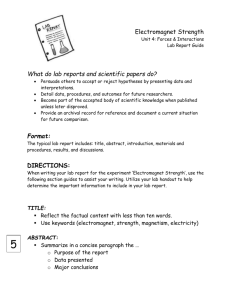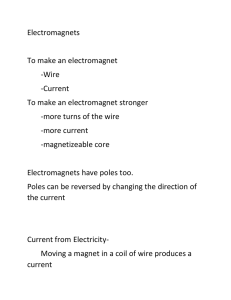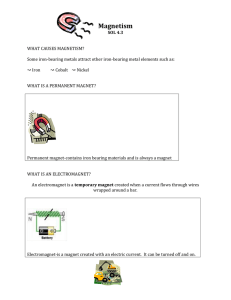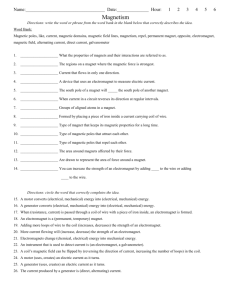Magnetism and Its Uses
advertisement
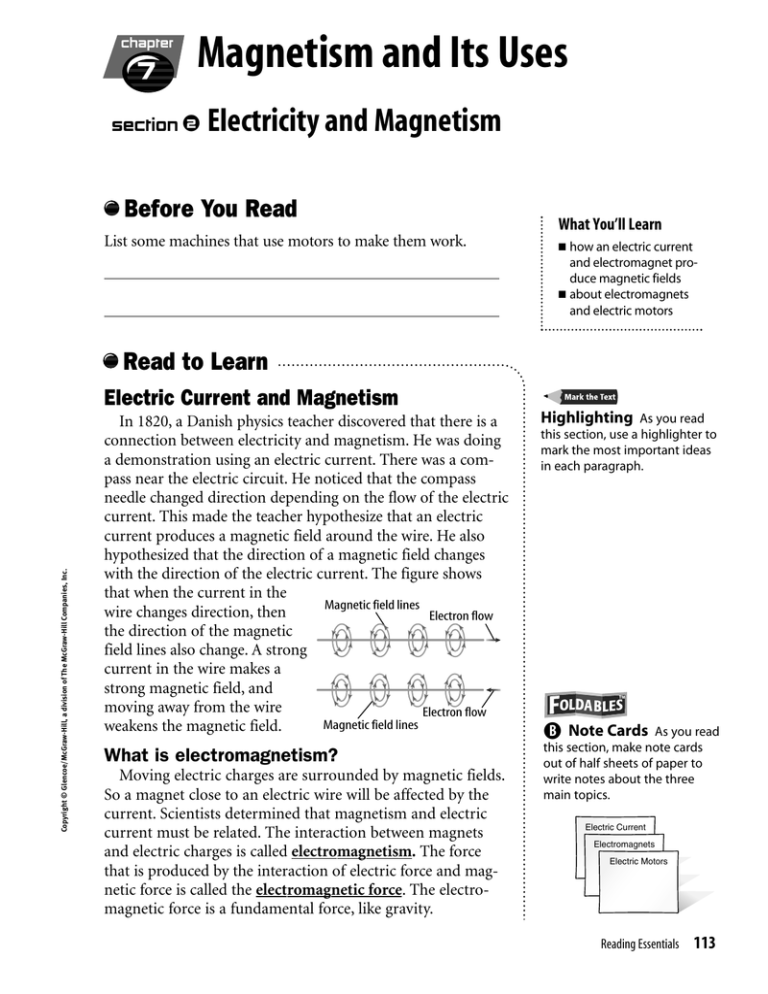
chapter 7 Magnetism and Its Uses 2 section ● Electricity and Magnetism Before You Read List some machines that use motors to make them work. What You’ll Learn how an electric current and electromagnet produce magnetic fields ■ about electromagnets and electric motors ■ Read to Learn Copyright © Glencoe/McGraw-Hill, a division of The McGraw-Hill Companies, Inc. Electric Current and Magnetism In 1820, a Danish physics teacher discovered that there is a connection between electricity and magnetism. He was doing a demonstration using an electric current. There was a compass near the electric circuit. He noticed that the compass needle changed direction depending on the flow of the electric current. This made the teacher hypothesize that an electric current produces a magnetic field around the wire. He also hypothesized that the direction of a magnetic field changes with the direction of the electric current. The figure shows that when the current in the Magnetic field lines wire changes direction, then Electron flow the direction of the magnetic field lines also change. A strong current in the wire makes a strong magnetic field, and moving away from the wire Electron flow Magnetic field lines weakens the magnetic field. Highlighting As you read this section, use a highlighter to mark the most important ideas in each paragraph. What is electromagnetism? this section, make note cards out of half sheets of paper to write notes about the three main topics. Moving electric charges are surrounded by magnetic fields. So a magnet close to an electric wire will be affected by the current. Scientists determined that magnetism and electric current must be related. The interaction between magnets and electric charges is called electromagnetism. The force that is produced by the interaction of electric force and magnetic force is called the electromagnetic force. The electromagnetic force is a fundamental force, like gravity. B Note Cards As you read ● Electric Current and Magnetism Electromagnets Electric Motors Reading Essentials 113 Electromagnets 1. Describe a solenoid. You can make a magnetic field stronger. This is done with a solenoid. A solenoid (SOH luh noyd) is a single wire carrying electric current that is wrapped into a cylinder-shaped coil. It looks like a spring. The figure to the right is a solenoid. Solenoid Electron flow S N 2. Explain How is a solenoid used to make an electromagnet? Picture This 3. Draw In the second figure, change the drawing of the electromagnet so that it will be stronger than the one shown. 114 CHAPTER 7 Magnetism and Its Uses A solenoid makes a magnetic field stronger. Suppose there is an electric current flowing through a wire. If a loop is formed out of the wire, the magnetic fields inside the loop combine. This makes the magnetic field inside a loop stronger than the magnetic field around a straight wire. Since a solenoid has many loops, the magnetic field inside it is even stronger. The solenoid is used to Electromagnet make an electromagnet. An electromagnet is a solenoid S N wrapped around an iron core. The figure to the right is an Electron electromagnet. The solenoid’s flow magnetic field temporarily magnetizes the iron core. The magnetic field inside the electromagnet can be 1,000 times stronger than the field inside a solenoid without an iron core. How do electromagnets behave? Electromagnets are temporary magnets. The magnetic field is present only when current is flowing in the solenoid. The magnetic field of an electromagnet can be made stronger by adding more coils of wire or by adding more current. An electromagnet acts like any other magnet. It has a north and a south pole, attracts magnetic materials, and is attracted or repelled by other magnets. If put in a magnetic field, an electromagnet will line itself up along the magnetic field lines. Electromagnets are useful because you can control how they act by changing the electric current flowing through the solenoid. When the current flows in the electromagnet and it moves toward or away from another magnet, electric energy is changed into mechanical energy. The mechanical energy will do work. Electromagnets make mechanical energy to do the work in many devices, such as stereo speakers and electric motors. Copyright © Glencoe/McGraw-Hill, a division of The McGraw-Hill Companies, Inc. What does a solenoid do? What makes an electromagnet rotate? A permanent magnet can apply forces on an electromagnet to make it rotate. The figure below shows an electromagnet between the north and south poles of a permanent magnet. The north and south poles of the electromagnet are attracted to the opposite poles of the permanent magnet. This causes a downward force on the left side of the electromagnet in the figure and an upward force on the right side. These forces make the electromagnet rotate until opposite poles are lined up. Electromagnet Electromagnet Picture This Permanent magnet Electron flow Permanent magnet Electron flow 4. Identify Which pole of the electromagnet is attracted to the north pole of the permanent magnet? The electromagnet continues to rotate until its poles are next to the opposite poles of the permanent magnet. Once the north and south poles of the electromagnet are in opposite directions, the electromagnet stops rotating. Copyright © Glencoe/McGraw-Hill, a division of The McGraw-Hill Companies, Inc. How do electromagnets make sound? There is an electromagnet in the speaker you use when you listen to a CD. The electromagnet is connected to a speaker cone made from paper, plastic, or metal. A permanent magnet surrounds the electromagnet. Changing Electric Current Recall that increasing the current passing through a wire increases the strength of a magnetic field. A CD player produces a voltage, a measure of electrical potential energy that can be changed into other forms of energy. As voltage increases, more electrical potential energy is ready to be changed into other forms of energy. The CD’s voltage produces an electric current in the electromagnet next to the speaker cone. The CD contains information that changes the amount of electric current and its direction. The changing electric current causes the direction and the strength of the magnetic field around the electromagnet to change. A change in direction causes the electromagnet to attract or repel a permanent magnet. This makes the electromagnet move back and forth causing sound. The electromagnet changes electrical energy to mechanical energy. The mechanical energy vibrates the speaker cone so it reproduces the sound that was recorded on the CD. 5. Determine What causes the speaker cone to vibrate? Reading Essentials 115 How does a fuel gauge work? 6. Analyze What would make the needle in the fuel gauge turn to the right? Electric Motors On hot days, do you use a fan to keep cool? A fan uses an electric motor. An electric motor is a machine that changes electrical energy into mechanical energy. The wires carrying electric current produce a magnetic field. This magnetic field acts in the same way as the magnetic field that a magnet produces. Two wires carrying electric current can attract each other as if they were two magnets, as shown in the figure below. Picture This 7. Trace the arrows between both the magnets and the wires that show the attractions. ron flo w Elect f l ow tron c e El 116 CHAPTER 7 Magnetism and Its Uses Copyright © Glencoe/McGraw-Hill, a division of The McGraw-Hill Companies, Inc. Picture This A galvanometer is a device that uses an electromagnet to measure electric current. Look at the first figure. It is a galvanometer. An electromagnet is located between the poles of a permanent magnet and is conScale nected to a small spring. The Needle electromagnet rotates until the force applied by the spring is Permanent Spring magnet balanced with the magnetic forces on the electromagnet. Wires Electromagnet A needle is attached to the carrying current to coil electromagnet, so it turns also. The second figure is a fuel gauge from a car’s dashboard. The fuel gauge is a galvanometer. When the amount of gasoline in the car’s fuel tank changes, the needle in the gauge moves. This movement is started by a sensor in the car’s fuel tank that tells when the fuel level changes. This sensor sends an electric current to the galvanometer. The current changes as the amount of fuel changes. The current change causes the electromagnet to turn. This makes the needle move to different positions on the gauge. The gas gauge is set so that when the fuel tank is full, the needle moves to the full mark on the gauge. Where are electric motors used? Electric motors are used in many types of machines. You can find these machines in industry, agriculture, and transportation. Objects as large as airplanes and cars use electric motors. Objects as small as personal-sized fans also use motors. You can find machines with electric motors in most rooms of your house. Almost every appliance with a moving part contains an electric motor. Electric motors are used in CD and DVD players, computers, hair dryers, electric fans, and many other appliances. How does a simple electric motor work? Copyright © Glencoe/McGraw-Hill, a division of The McGraw-Hill Companies, Inc. Any machine that changes electric energy into kinetic energy is a motor. A motor is a permanent magnet and an electromagnet connected to an electric source. The electromagnet is positioned so that it is able to spin in the magnetic field of the permanent magnet. Electricity from the source creates the magnetic field of the electromagnet. The opposite poles of the two magnets attract one another and the electromagnet spins. The wire ends of the electromagnet rub against a circular device that is split so that the current reverses in the electromagnet at the midpoint of its spin. This allows it to spin continuously as its poles change and interact with the poles of the permanent magnet. The figure shows a simple motor set up. 8. Identify What is a machine that changes electric energy into kinetic energy called? Simple Electric Motors Picture This Electron flow – + Electron flow 9. Determine In the figure on the right, which direction will the loop spin, clockwise or counterclockwise? Battery Reading Essentials 117 After You Read Mini Glossary electromagnetic force: the attractive or repulsive force electromagnetism: the interaection between electric between electric charges and magnets electric motor: a device that changes electrical energy into mechanical energy electromagnet: a single wire carrying an electric current that is wrapped around an iron core charges and magnets galvanometer: a device that uses an electromagnet to measure electric current solenoid: a single wire carrying electric current that is wrapped into a coil shaped like a cylinder 1. Review the vocabulary words and their definitions in the Mini Glossary. Write a sentence that shows how a solenoid and an electromagnet are related. 2. Complete the diagram to list three items that use electromagnets to make them work. 3. Look at the parts of the text that you highlighted. How did this help you to learn about electricity and magnetism? 4. What could you do if something you highlighted didn’t make sense to you? End of Section 118 CHAPTER 7 Magnetism and Its Uses Copyright © Glencoe/McGraw-Hill, a division of The McGraw-Hill Companies, Inc. Use electromagnets to make them work

